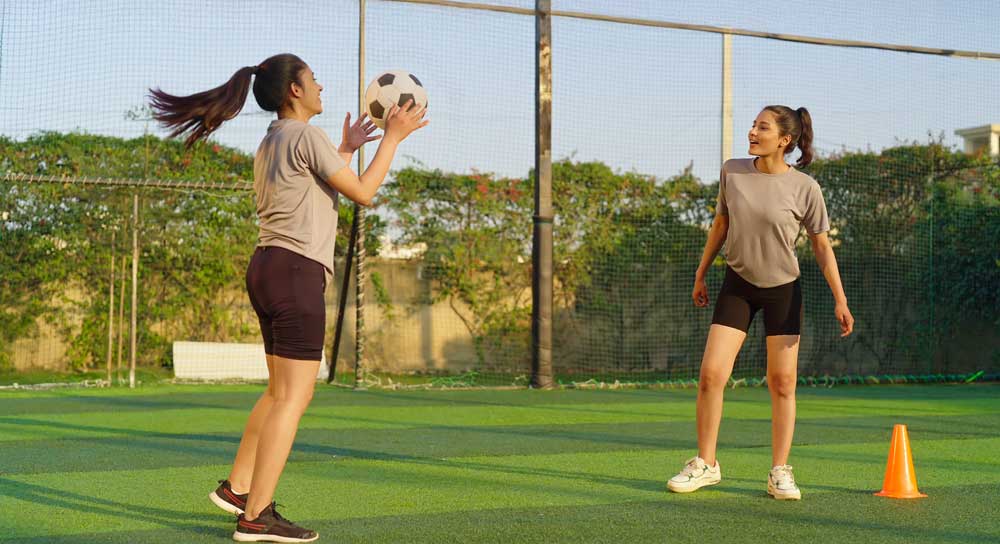India celebrates National Sports Day on August 29, in memory of hockey legend Major Dhyan Chand. It’s also an ideal moment to spotlight the remarkable, yet underrepresented journeys of Indian women in sports. This includes their triumphs, challenges, and the urgent need for support to help them flourish.
The Challenges Women Athletes Face
Even now, there are grassroots barriers for women in India who want to pursue sports. A 2024 report covering states like Rajasthan, Haryana, Manipur, and Bihar shows that nearly 48 per cent of women athletes must travel over 10 kilometers just to access training facilities, often via unsafe or unreliable transport. This creates physical, psychological, and safety-related barriers.
The National Sports Policy (NSP) 2025 was released in mid-2025 and focusses on inclusion and infrastructure. However, there are no enforceable targets or accountability mechanisms, especially regarding women athletes. Cricket alone captures nearly 88 per cent of India’s sports market and sponsorships, leaving minimal support for other disciplines where women more often feature. Initiatives like Khelo India are valuable, but not enough to overcome the gaps in facilities and opportunities.
Representation, Leadership And Research Gaps
Women coaches, administrators, and support staff remain sparse. Institutions are often reluctant to promote women, based on assumptions about mobility or commitment levels. In a rare case, long jumper Anju Bobby George, who won India’s first world athletics medal in 2003 now chairs the Athletics Federation of India. But those instances are few and far between.
Most sports science research remains male-centric. Female athletes continue to face training methods that are misaligned with their physiological needs, such as hormone cycles, injury patterns, and postpartum recovery. Even top athletes like Saikhom Mirabai Chanu have highlighted how menstrual cycles impacted performance, yet there aren’t standard systems to address this.
Traditional norms often emphasise academics, domestic roles, or risk aversion, pushing girls out of sports early. Safety concerns, lack of toilets or changing rooms, or absence of chaperones contribute to high dropout rates. In 2024, UNESCO data revealed that 49 per cent of girls drop out of sports, a rate six times higher than boys, with 21 per cent citing childhood abuse as a factor.

A Few Success Stories
Despite these challenges, there are a few legends who have made an attempt to pave the path for future generations. PT Usha, a pioneer in Indian track and field, overcame poverty in Kerala to win 23 medals for India. Karnam Malleswari became the first Indian woman to win an Olympic medal in 2000 despite very little support. Saina Nehwal, badminton’s former World No 1, shattered expectations with her Olympic success despite early language and social challenges. Mary Kom’s rise from a marginalised background in Manipur to global boxing stardom is now legendary. Sarika Kale, Captain of India’s women’s kho kho team, led her team to gold despite coming from a financially challenged family, becoming the first kho kho player to earn the Arjuna Award in decades.
On the flip side, there is also the case of women athletes like Santhi Soundarajan. A Tamil middle-distance runner, Santhi lost her 2006 Asian Games medal following a controversial gender test, highlighting how gender policing can derail careers.
What’s Happening Now
The new Sports Bill (2025) includes provisions to enhance women's representation in sports governance. Platforms like The Sports Women and Capri Sports Foundation are empowering underprivileged girls through grassroots sports, storytelling, menstrual literacy, and creative campaigns, reaching over 10,000 girls. The use of data and technology highlights the need for female-specific equipment and performance analytics. This is emerging as a tool to counteract long-term neglect in women's sports science.
What Needs To Change
1. Policy
There should be enforceable gender targets in NSP and federations. A minimum of 30–50 per cent women’s representation in leadership, coaching, and selection committees should be mandated. There should also be gender parity in funding and grants, and bodies must be established to monitor equity in sports.
2. Infrastructure And Investment
Ensuring safe infrastructure is non-negotiable. This should include clean toilets, changing rooms, safe transport, and chaperoned pathways. Facilities must be expanded in underserved areas, ensuring equitable access for girls in district and block-level hubs. Corporate engagement in women’s sports can also create more inclusive CSR strategies. Investment in female-centric sports research is a necessity, from training methods to injury prevention. Leverage smart wearables and virtual coaching tools, particularly in remote regions. Sportswomen should be provided with maternity and postpartum support, including nutrition, recovery protocols, and flexible training pathways. Initiatives can be established to recruit and train more women coaches, sports scientists, physiotherapists, and administrators to create empathetic support systems.
3. Social Shift
The launch of mass media campaigns celebrating female athletes can help normalise sports as a viable career path. It is also vital to incorporate sports in the school curriculum, ensuring girls have early access and encouragement.
National Sports Day should be more than just a one-day celebration. It should be a constant movement where gender equity isn't aspirational and every girl has the right to pursue sports as a career path.